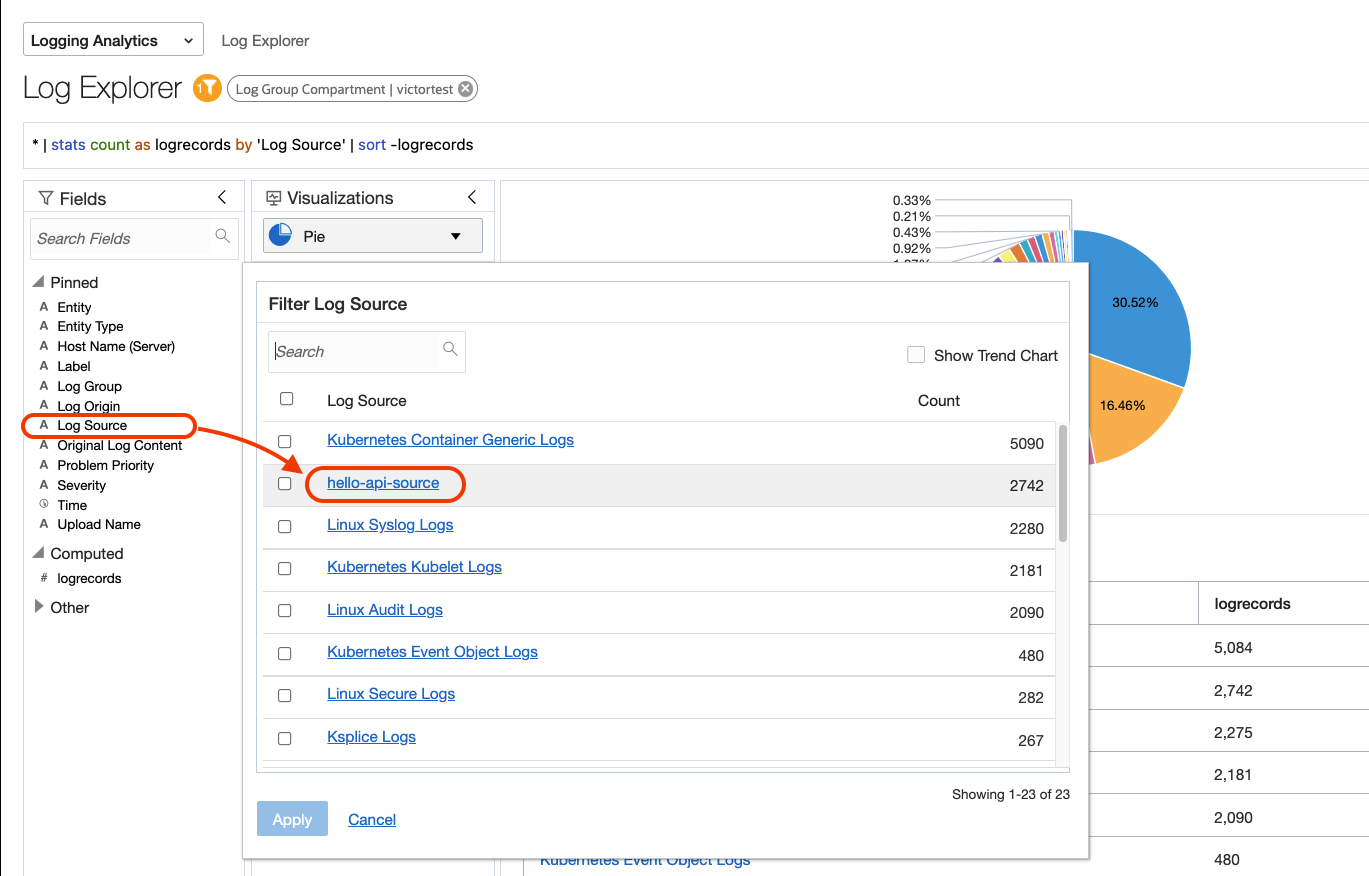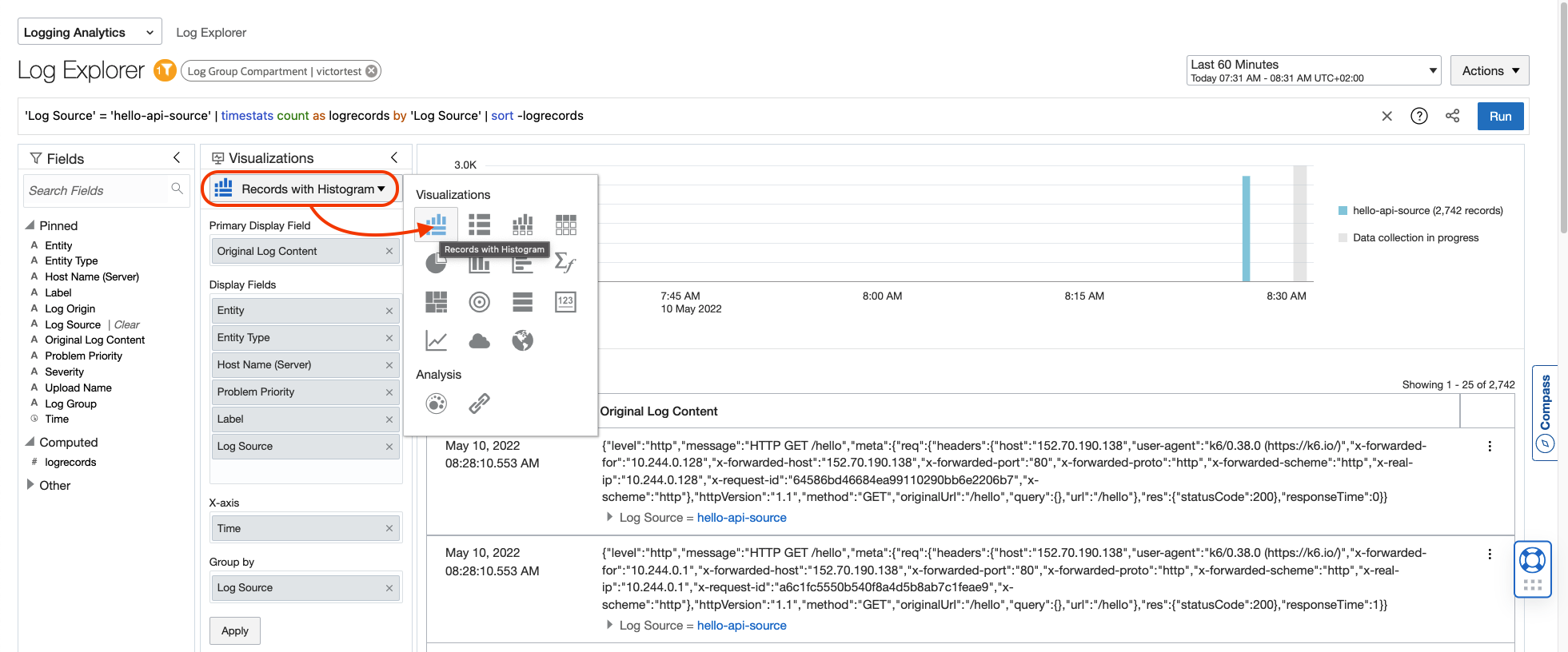This project is an OCI Logging Analytics "Hello World" with OCI Kubernetes.
This project is composed of:
- Hello World API app in Node.js (no db connectivity yet)
- Terraform scripts for Oracle Kubernetes Engine
- Deployment manifest for app with terraform helm_release.
Work in Progress
- OCI Logging Analytics on-boarding within the terraform script.
Requirement: Logging Analytics enabled on the OCI Region (Quick Start).
Create a Dynamic Group called dynamic-group-oke-node-pool that matches OKE node pool workers with matching rule:
All {instance.compartment = '<COMPARTMENT_NAME>'}
You have to replace
<COMPARTMENT_NAME>for the compartment name where your Kubernetes Cluster is going to be created.
Create a policy to allow access to Log Group with the following rule:
Allow dynamic-group dynamic-group-oke-node-pool to {LOG_ANALYTICS_LOG_GROUP_UPLOAD_LOGS} in compartment <COMPARTMENT_NAME>
Go to Menu > Observability & Management > Logging Analytics > Administration.
On the side menu, click Sources.
Click Create Source and fill the form with the following information:
- Name:
hello-api-source - Description:
Hello API App Source - Source Type:
File - Entity Types:
OCI Compute Instance - Parser:
Automatically parse time only
Click Create Source to confirm.
Go to OCI Web Console and open Cloud Shell.
Clone this repository with:
git clone https://github.com/vmleon/oci-hello-loganalytics.git
Change directory to oci-hello-loganalytics/provisioning:
cd oci-hello-loganalytics/provisioning
Terraform initizate:
terraform init
Before we apply the infrastructure with terraform, we need to set some variables.
Let's start with copy the template variable file:
cp terraform.tfvars_template terraform.tfvars
Get the values and copy them aside from running these commands
Region:
echo $OCI_REGION
Tenancy:
echo $OCI_TENANCY
If using the root compartment (trials) for
compartment_ocidset theOCI_TENANCYvalue as well, otherwise, use the specific OCID compartment:Do you want to search for a specific compartment by name? Use the following command and replace
<COMPARTMENT_NAME>by the name of the compartment.oci iam compartment list \ --all \ --compartment-id-in-subtree true \ --query 'data[0].id' \ --name <COMPARTMENT_NAME>
Edit the file with vim:
NOTE: You can leave empty the
profileproperty
vim terraform.tfvars
An example of the final result would be:
region = "eu-frankfurt-1"
tenancy_ocid = "ocid1.tenancy.oc1..aaa............."
compartment_ocid = "ocid1.compartment.oc1..aaa.............""
profile = ""
Run the Terraform apply:
terraform apply -auto-approve
After 10 to 20 minutes the resources should be created.
You will see something like this:
Apply complete! Resources: 19 added, 0 changed, 0 destroyed.
Outputs:
deployed_oke_kubernetes_version = "v1.22.5"
generated_private_key_pem = <sensitive>
kubeconfig_for_kubectl = "export KUBECONFIG=$(pwd)/generated/kubeconfig"
Run that last command:
export KUBECONFIG=$(pwd)/generated/kubeconfig
With the KUBECONFIG exported you can use kubectl to get some information
Kubernetes Nodes:
kubectl get nodes
Kubernetes services:
kubectl get services
You can also list the helm app installed with:
helm list
Make sure the application hello-api is successfully deployed.
Get the public IP of the load balancer into the variable LB_PUBLIC_IP:
export LB_PUBLIC_IP=$(kubectl get services -o jsonpath='{.items[?(@.spec.type=="LoadBalancer")].status.loadBalancer.ingress[0].ip}')
Print the IP, it should return a valid public IP address.
echo $LB_PUBLIC_IP
You are going to generate some workload and therefore logs to be explored with Logging Analytics. We are using a tool called k6.oi run in a container locally.
docker run -i grafana/k6 run -e LB_PUBLIC_IP=$LB_PUBLIC_IP - <../load/test.js
Finally, generate an error with this curl command on an endpoint that doesn't exist.
curl -s http://$LB_PUBLIC_IP/nofound
Go to Menu > Observability & Management > Logging Analytics > Log Explorer.
On the filter menu on the left, click on Log source and select hello-api-source.
Select Records and Histograms as visualization.
Try out this query in Log Explorer
'404' and 'Log Source' = 'hello-api-source' | timestats count as logrecords by 'Log Source' | sort -logrecords
You will see the log errors 404 you generated with the /notfound path.
Before destroy you need to purge logs.
With Web Console: Go to Menu > Observability & Management > Logging Analytics > Administration. Go on the side menu to Storage. Click the red button Purge Logs. Select your Log Group Compartment. Click Purge.
Wit the OCI CLI (Terminal):
oci log-analytics storage purge-storage-data \ --namespace-name $(oci os ns get --query 'data' | tr -d '\"') \ --time-data-ended $(date -u +%FT%TZ) \ -c $COMPARTMENT
Go to Menu > Developer Services > Resource Manager > Stacks.
Click on your stack.
Open Show Advanced Options and disable Refresh Resource States Before Checking For Differences.
Then confirm by clicking on Destroy.
Finally run:
FIXME: refresh false because error with
helm_release
terraform destroy --refresh=false -auto-approve
After few minutes you will see that the resources has been destroy.


